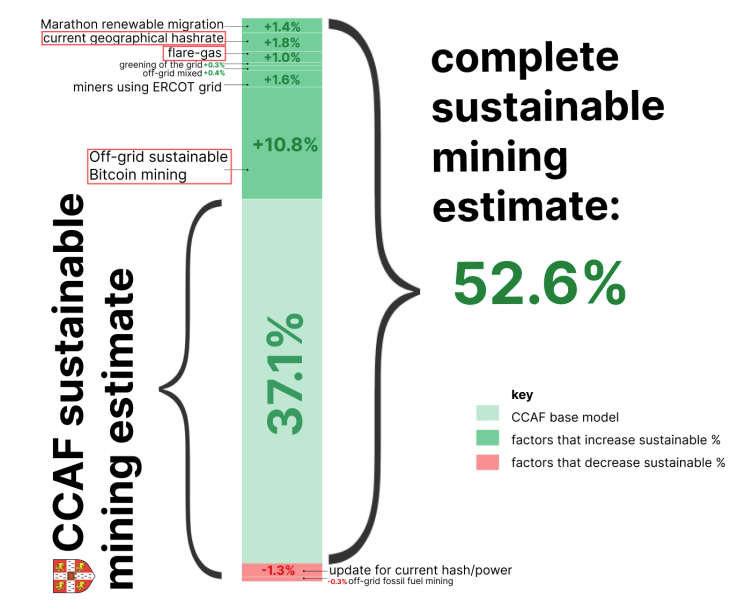Amidst the fast evolution of the high-tech and ever-evolving panorama of Bitcoin mining, an intriguing discovery has emerged from one of many trade’s main Bitcoin vitality researchers.
In accordance with Daniel Batten, creator of the Cambridge Bitcoin Electrical energy Consumption Index (CBECI), three exclusions talked about on its web site have understated Bitcoin’s sustainable vitality share by 13.6%.

When all is correctly tallied, the creator of the unique examine says, Bitcoin’s vitality sustainability trickles over the 50% mark, with 52.6% of Bitcoin mining being completed sustainably.

The analysis carried out by the CBECI was launched to deploy a data-based evaluation of Bitcoin’s electrical energy utilization and, prior to now, was met with mounting public concern concerning the problem.
In abstract, the CCAF mannequin didn’t issue within the following:
- Off-grid mining (influence: plus 10.8%)
- Flare-gas mining (influence: plus 1.0%)
- Up to date geographical hash fee (Kazakhstan miner exodus, influence: plus 1.8%)
With all exclusions factored in, the sustainable vitality combine calculation is 52.6%.
Since 2019, the CCAF’s efforts to broaden the scope of the Index has aimed to offer the foundational components required for a complete understanding of Bitcoin’s influence on the surroundings.
How can we ensure that the info is correct?
The reply to this query could be simulated utilizing a revised mannequin, in keeping with researchers.
For Bitcoin’s true sustainable vitality use to be under 50%, no less than one of many following situations must be true:
- 4 massive Bitcoin mining operations secretly run off 100% coal-based vitality.
- ERCOT (The operator of Texas’s electrical energy grid) has over-reported its true renewable vitality numbers by an element of 4.
- Regardless of the widely-reported exodus of miners from Kazakhstan, its declare on Bitcoin mining elevated its share of the worldwide hash fee from 13.2% to twenty%.
Researchers say these are primarily based on findings from the unique CCAF findings — which return to 2019 and now must be revised.
What this implies for sustainable mining
With the emergence of a authentic, data-driven strategy to deal with the issues raised by the CCAF examine, Bitcoin advocates might lastly have the ability to take away the roadblock inhibiting Bitcoin’s adoption amongst Environmental, Social, and Governance (ESG) buyers.
“For the primary time, Bitcoin advocates have a authentic, data-based technique to take away the roadblock that the CCAF examine has for a while created within the minds of ESG buyers.”
The creator argues that this will additionally influence policymakers who take a look at the report.
“Previous the primary hurdle, proponents of Bitcoin can ask the subsequent two large questions that ESG buyers and the White Home have: Is Bitcoin’s macro-trend quantifiably shifting towards sustainable vitality? And is Bitcoin quantifiably a internet optimistic to the surroundings and society?”
With the Cambridge report’s revised findings into the sustainability of Bitcoin mining, Bitcoin advocates and ESG buyers can argue that authentic proof-of-work cryptocurrency is primarily sustainable, probably positioning it as a pacesetter in sustainable vitality adoption throughout all industries.


